
14 minute read
Farm to fashion
Katie Robson makes bags and accessories from cow hides.
THE BRAINCHILD OF A FARMING LIFE
HEATHER LARGE MEETS A SHROPSHIRE WOMAN CREATING BESPOKE BAGS FROM COWHIDES
In a workshop on a north Shropshire dairy farm, Katie Robson transforms British cowhides into bespoke leather bags and accessories. The craft combines both her love of farming and the countryside with a passion for art and design.
Despite not growing up on a farm, the 27-yearold says has always been drawn to the way of life, especially since moving to Shropshire with her parents seven years ago.
Now she lives with her partner James on his dairy farm on the outskirts of Whittington, near Oswestry, where she lends a hand with milking, calf feeding and lambing.
Four years ago she was inspired to get creative when she saw an opportunity to utilise cowhides that are a by-product from the meat industry.
“When we had some animals go off to slaughter we were asked if we wanted one of the hides back to go on the floor at our new house. We said yes, had it tanned and sent back.
“Prior to this I had been on a few leather courses. It was something that always interested me as I had horses and wanted to know how to repair leather saddles and bridles. My mum is a dressmaker by trade so I’ve grown up sewing with her. “We got the hide back and I got a bit scissor happy and cut it up to my partner’s disgust to make a bag. “I had an idea and wanted to see if it would work,” explains Katie, who works for Genus as an artificial insemination reproduction specialist. This would be the start of new business, Robson & May, and soon she was sourcing more cowhides and designing a range of bags and accessories including her popular bow ties from the soft leather. Working with a natural product means everything she makes is unique due to the variations in the patterns and colours on each hide.
From one side of a hide, she will make eight or nine bags and each one will take her around three to four hours to complete.
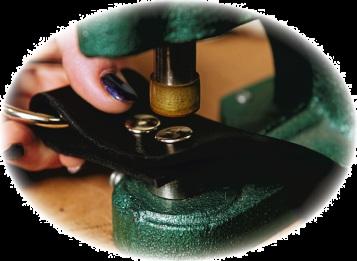
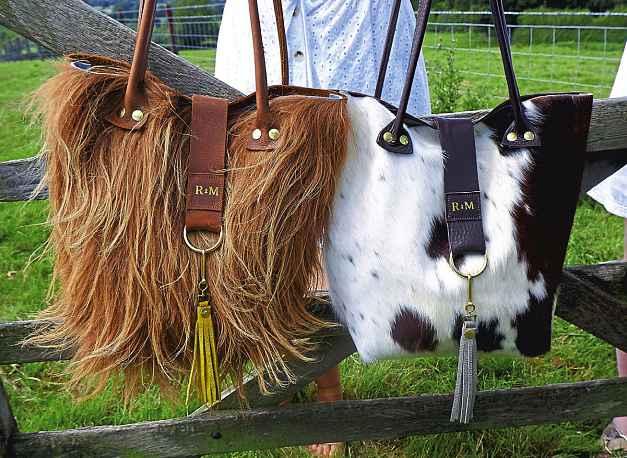
Katie’s product range includes backpacks, clutch bags and totes.
Her product range includes backpacks, clutch bags and totes, as well as coin purses, and off-cuts are used for smaller items such as keyrings.
“I try to use as much as possible to reduce waste. I want each hide to be used to its full potential,” says Katie.
“It is a fantastic material; so much choice, colour, texture and the possibilities are endless when designing with leather. It’s not the easiest material to work with as it is very slippery when sewing, but I believe it is worth it for the end product.”
To bring her different designs to life, she works with a wide range of hides include those of shorthorn, Highland and Hereford cattle.
Other materials used in her designs include feathers and cartridges that are locally sourced from their own shoot in Llansantffraid and Oswestry.
As well as having an elegant and modern look, it’s important to Katie that her products are also practical and will stand the test of time.
“People are buying something that it unique, that no one else has. To some people, it might feel slightly strange to be touching a real cowhide, but to me and hopefully others it brings a sense of luxury to my items,” she says.
One of the challenges Katie has faced since starting her business is sourcing British cowhides as she says many of them are exported to Europe.
A large number of tanneries have shut their doors in recent years, Katie explains, which means there are fewer places where the skins can be processed.
Before Katie can use a cowhide, the skin needs to be preserved and transformed into leather which retains the original colouring and hair of the animal.
“It is getting harder to source British cowhide. There used to be 124 tanneries in the UK, now only 23 are running.
“A lot of hides are being exported to Italy and no longer staying in this country which I find very sad.

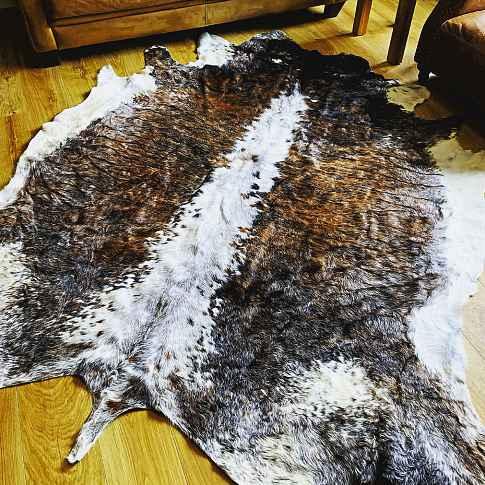
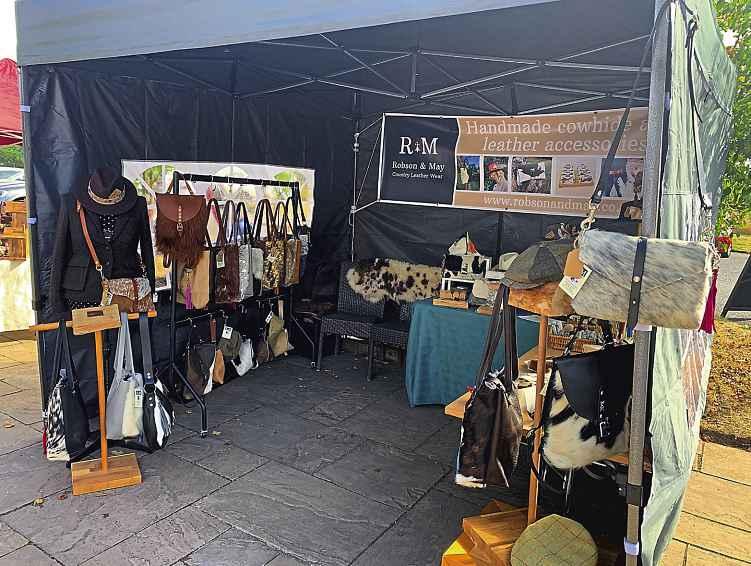

“I can go online and buy foreign ones but I want to use British hides and keep British hides here,” she explains.
Katie has recently launched a new service offering the hire of luxury cowhides, sheepskins, reindeer hides and other hides for weddings and events.
The idea came to her after she was approached by people asking if they could borrow hides for family farm weddings. “I looked into it more and realised there was a shortage of companies hiring hides out for events,” she explains. Running her cowhide business alongside her day job and farm duties, brings her a lot of enjoyment. “I love designing and sewing. I’m always scribbling ideas down and drawing.
“When a customer says ‘I absolutely love the bag’, I think ‘I’ve made that’, it makes me feel very proud,” says Katie.
She also feels passionate about farming and is pleased to be playing her part in championing the industry and also the county.
“As farmers raising our animals with such care and love, knowing that every part of them is used is very rewarding and satisfying,” says Katie.
n For more information, see www. robsonandmay.co.uk

THROUGH FIELD AND FOREST
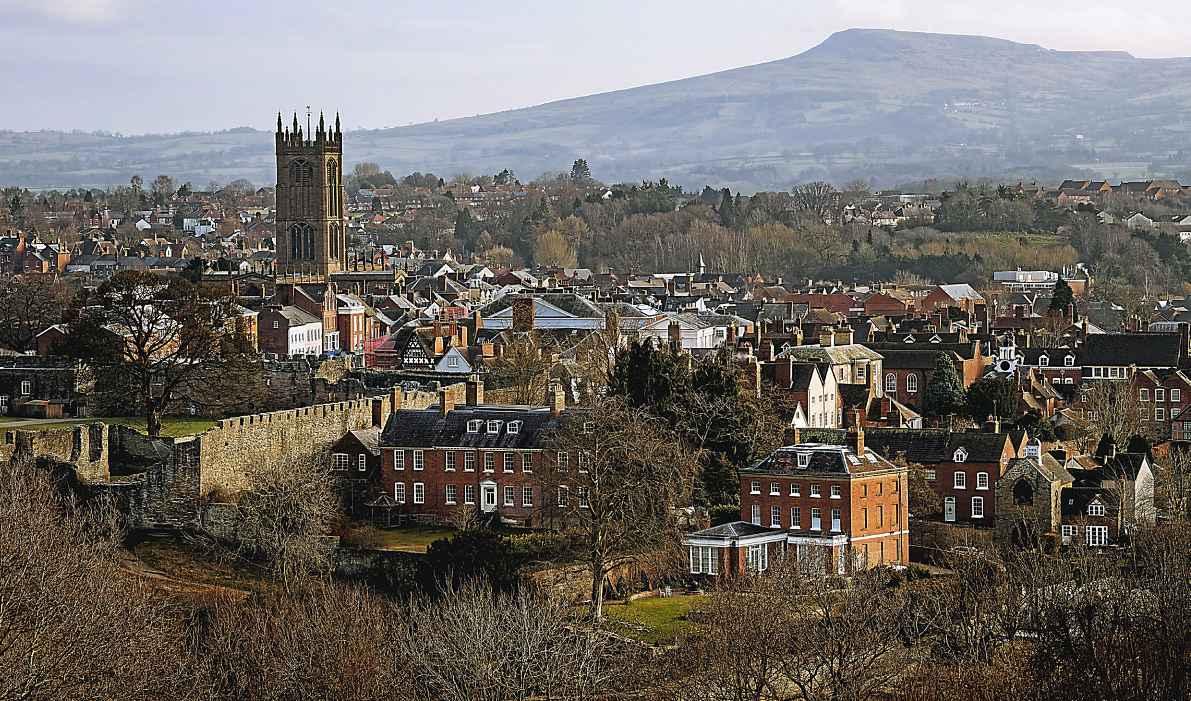
View of Ludlow and Ludlow Castle from Whitcliffe Common; below, Mortimer Forest.
BY ANDY RICHARDSON
Ludlow is one of the county’s finest towns from which to walk. There are myriad routes while all roads lead back to the town centre, which is full of bustling, independent cafes and bistros.
This five-mile walk across a mixture of farmland and forest provides an interesting, dog-walker-friendly ramble that will take around 90 minutes to complete. The terrain is easy to moderate with two stiles, and the start point is either Castle Square, in Ludlow, or Whitcliffe Common, depending on where you park.
From the castle entrance take the path to the right, the Mortimer Trail, down to Dinham Bridge. Cross the bridge, turn left, leave the Mortimer Trail, and take the path beside the River Teme. It’s called the Breadwalk. In just over a quarter of a mile, climb the steps. At the top, after an information board, turn right 90 degrees up to the road at a layby. Cross the road and walk down to the left about 30 yards.
Take the path on the right by a fingerpost through trees to exit on the Overton Road. Turn right and walk for half a mile.
At a property named Mabbit’s Horn, (opposite a fingerpost), turn right up the drive, pass the house on a path, to a gate and into a field. Continue for a quarter of a mile. This is the line of the old toll road south out of Ludlow.
The path diverges: the main route carries straight on and continues to a kissing gate. Cross two fields with stiles beside field gates to a metalled drive and down a bridleway to the road in Overton. Note the sunken nature of the track, suggesting that it is a section of the old toll road.
At the road turn right. Take the first turn right on a vehicle track with Private Road and barrier into woodland. After a Forestry Commission sign, for Sunny Dingle, the route reaches another track bending tightly round and rising to the right. Take this right on the forestry road.
The route passes a cottage on the left and bends to the right. It is joined by a path from the left, waymarked with two colour signed trails, Climbing Jack (white) and Mortimer Trail (green). It climbs a hill under a rocky cliff.
At the top, where the road bends left, the path joins from the right. Climb a little more to the end of this section. At a slight bend to the left, at a junction of tracks, with a bench on the left, leave the Mortimer Trail and turn right on the narrow path, the Whitcliffe Loop (red discs). At the junction, turn left on the red disc trail uphill.
Follow the trail to turn right. A track joins from the right. Carry on until a junction, follow the red discs and bear left. At the forestry road turn right on the Whitcliffe Loop and the Mortimer Trail, down a slope past an F.C. barrier and a District Office, to the Wigmore road.
Cross over and from the layby left side take the footpath down, right of a prohibition notice for horses and cycles.
The Mortimer Trail bends to the right and descends for over half a mile, joined by a path on the right, down to Lower Wood Road.
Turn right, then right again up the hill for 40 yards.
Beside an information board on the left for Whitcliffe Common, follow the Mortimer Trail to a short flight of steps down to Dinham Bridge for Castle Square.
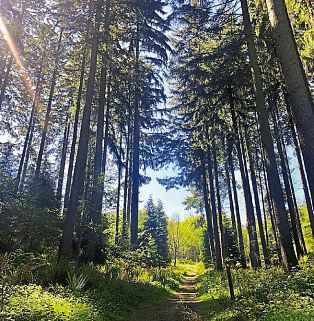
Despite whipping up an admirable array of cakes, cookies and pastries on last year’s series of The Great British Bake Off – impressing the judges so much he was crowned the winner –Giuseppe Dell’Anno doesn’t have much of a sweet tooth.
“I don’t usually get cravings for sweet bakes,” the 46-year-old admits. Instead, he’s all about the savoury treats. “Very few things give me as much pleasure as the smell of baked savoury goods, like a warm loaf of bread, or some focaccia. Baked focaccia, that to me is heaven on a plate.”
The Italian baker – who is now based in Bristol – has written his first cookbook, dedicating it to the bakes of his homeland. He might not have a sweet tooth, but he still says: “I enjoy the process of baking – and most crucially, the joy of sharing the baked goods with others, more than stuffing my face. I don’t dislike a nice lump of cake – in the process of writing that book, I put on 13 kilos in less than a year… I’ve literally ‘proved’!”
Many of the recipes in the book are ones Dell’Anno ate growing up, made for him by his father. “My dad was a professional chef and baker by passion. He’s always done it with a passion – for him, it’s never been work – and he didn’t stop at work.
“Before leaving the house in the morning, he would prepare lunch for everybody, then he would go to work, cook and bake the whole day, then come back and do the same for family and friends. It’s been his life effectively, since he started working in his early teens.
“I was born into that environment

ITALIAN BAKER GIUSEPPE DELL’ANNO TALKS TO PRUDENCE WADE ABOUT LEARNING FROM HIS FATHER AND PREFERRING SAVOURY TO SWEET
– I remember vividly Sunday mornings, waking up relatively late and my dad was already folding tortellini for lunch, and putting together the cake for after lunch – because in Italy back in the day, Sunday cake or pastries were a thing after lunch.”
But that doesn’t necessarily mean Dell’Anno was helping his dad in the kitchen from a young age. “Funnily enough, having all of that readily served to me, I never needed to learn how to bake –because I was surrounded by all that stuff every single day,” he confesses. “It’s only when I left home at 18 and I realised it was not the same for everybody, that I’d been very lucky to have all of that – then I started to learn things myself.”
While Dell’Anno’s father didn’t teach him, he says: “Observing him doing things over and over again had given me that sixth sense that you need to work out how things are done. So when I actually started actively learning things, for me it was an easy journey – because I’d seen it all before.”
His heritage wasn’t the only thing that made baking come easily. Before winning Bake Off, Dell’Anno worked as an engineer. “Baking is all about being accurate and precise, weighing your ingredients, following baking temperatures and recipes. Accuracy is a big part of baking, and engineers are by trade accurate people. In my case even more so, because I’m a materials engineer – so I bake materials.”
Dell’Anno adds: “I used to deal with very large ovens to bake aeroplane wings –now I’m just making cakes or biscuits.”
Despite already being an excellent home baker, Dell’Anno is quick to stress just how much he learned from the show.
“Going on Bake Off – this applies for every baker on the show – you’ve got to learn things you’ve never done before. Regardless of how good a home baker you are, home bakers usually have their own skills, they’re good at a few things, but they’re not good at everything. Whereas on the show, you’ve got to do pretty much everything – from ice cream to fried goods to yeasted baked cakes to mousses, and many elaborate things.”
Dell’Anno adds with a laugh:
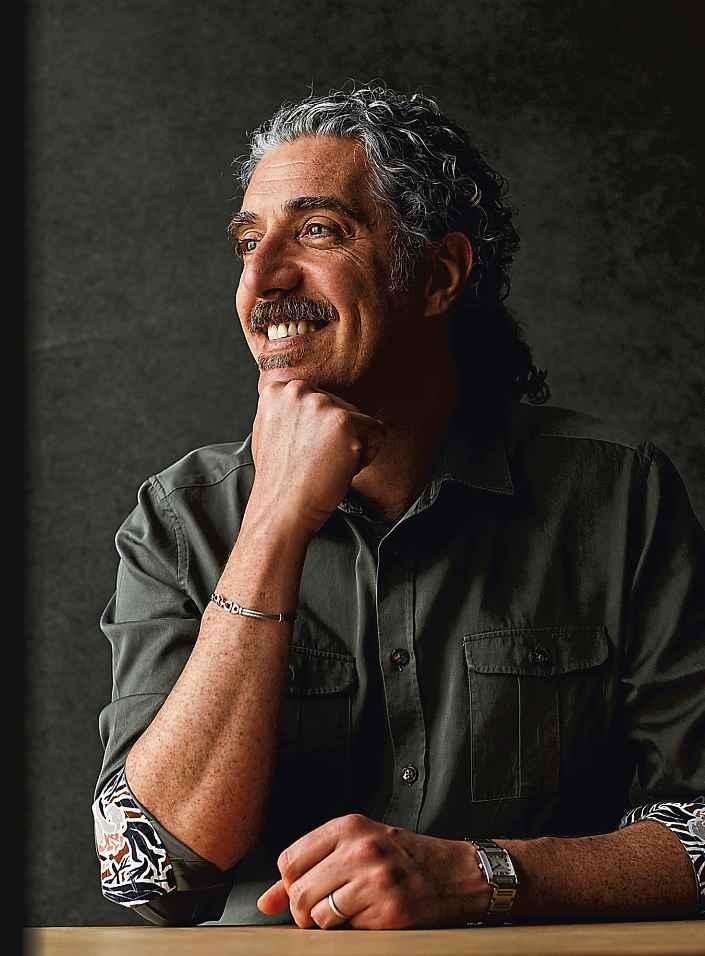
“Undeniably, a lot of those things I had never seen before. It’s almost a trite thing to say, but you get a boost in confidence because effectively you’re forced to do things you wouldn’t even touch with a stick otherwise. And at the end of the day, you realise they are not as difficult as they might look or they might seem.”
Exceptional baking skills and a mastery of the mirror glaze wasn’t the only gift the show gave him. Dell’Anno won legions of fans for his gentle and friendly demeanor, but he was nervous about how the public would react to him.
“I’m a very insecure man, very insecure,” he says. “I was terrified at the idea that I was going to be putting myself on the TV screen, because acceptance for insecure people is always a big thing. I literally lost sleep over the idea that I might not get accepted – I might get trolled on Twitter, like has happened to other bakers in the past – that my features would be picked on and my accent – all these things start to grow in your head.
“And none of that happened. Nothing of what I was fearing most happened –quite the opposite actually. It has changed me, in the way that having gone through that validation process on an epic scale, on such a big, high-profile show. It took me 46 years and a national TV show to realise that it’s just in our head – all of these problems, all of these issues that we create for ourselves, in terms of how others perceive us.
“It doesn’t matter how quirky you may come across or may look, or how unusual the things you do might be, there is always going to be somebody out there who appreciates you for who you are.”
Dell’Anno accepts he was extremely “privileged” to have this experience, saying: “I wish there was a way for all insecure people to have this sort of therapy – for me, it’s been a massive form of therapy, going on Bake Off.”
n Giuseppe’s Italian Bakes by Giuseppe Dell’Anno is published by Quadrille, priced £20.
Giuseppe’s amaretti recipe
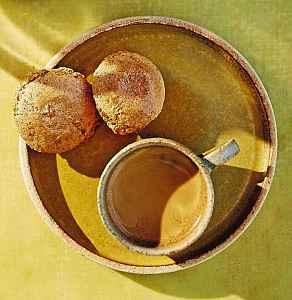
Ingredients:
(Makes about 50) 250g icing sugar, plus extra for dusting 90g unblanched whole almonds 10g bitter apricot kernels ⅛tsp salt 1 egg, white only 1tsp vanilla bean paste ¼tsp natural almond extract
1. Place 150 grams of the icing sugar in a food processor bowl, add the almonds and apricot kernels, then blitz for 40 seconds until the mixture is very fine. Add the remaining icing sugar and the salt, then blitz again for 40 seconds. Add the egg white, vanilla and almond extract, then blitz one final time until the mixture becomes a smooth, doughy mass. Turn the dough onto a dry worktop, press it down and fold it in half a few times with the help of a scraper. The dough will be quite sticky. Wrap the dough in clingfilm and leave it to rest in the fridge overnight. 2. The next day, preheat the oven to 160C and line a baking sheet with baking paper. 3. Take the dough out of the fridge, unwrap it (keep the clingfilm) and use the pressing and folding action again a few times. Divide the dough into small chunks of about seven grams each. 4. Shape each into a small ball, then arrange on the lined baking sheet. Form enough biscuits to fill one baking sheet (about 15), wrap the rest of the dough back in its clingfilm and store it in the fridge until the next batch. 5. Spray water on to the biscuits until their surface is completely wet. Dust the top of the biscuits with a thin layer of icing sugar and place the baking sheet in the oven for 17–18 minutes until the biscuits are a light caramel colour. 6. Once cooked, slide the baking paper on to a cooling rack and leave the tray to cool as you start the next batch.







